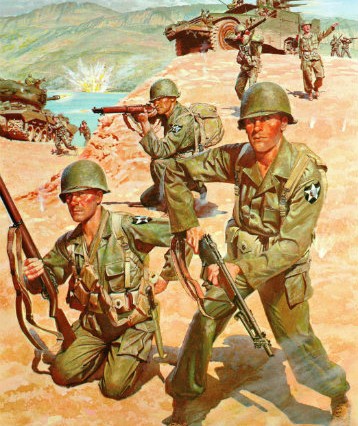Introduction
This song is based on the “Caisson Song” written by field artillery First Lieutenant Edmund L. Gruber (1879–1941) while stationed in the Philippines in March 1908. Its original lyrics described the routine activities of a horse-drawn artillery battery, and it quickly became popular in field artillery units. (A caisson is a two-wheeled cart designed to carry artillery ammunition.) Nine years later, the great composer and bandmaster John Philip Sousa (1854–1932) was asked to transform the song into a march. Sousa’s version proved a chart-topper, becoming the Army’s most popular melody. In 1956, the song (with revised lyrics) was adopted as the official song of the Army. It is played at the conclusion of every Army ceremony, and all soldiers are expected to stand and sing.
What story does this song tell about the Army? What is the Army’s mission, and what challenges does it face? What are the main characteristics of the Army (and an Army soldier) as described by the song? Why does the song include a retreat (“Valley Forge”) and a disastrous defeat (“Custer’s ranks”) alongside the Army’s achievements? What is the meaning of its title, and what does it suggest about the Army? Why do you think the Army chose this song as its anthem? How does it compare to the anthems of the other military branches?
(Intro)
March along, sing our song, with the Army of the free
Count the brave, count the true, who have fought to victory
We’re the Army and proud of our name
We’re the Army and proudly proclaim
First to fight for the right,
And to build the Nation’s might,
And the Army Goes Rolling Along
Proud of all we have done,
Fighting till the battle’s won,
And the Army Goes Rolling Along.
(Refrain)
Then it’s Hi! Hi! Hey!
The Army’s on its way.
Count off the cadence loud and strong (TWO! THREE!)
For where e’er we go,
You will always know
That The Army Goes Rolling Along.
Valley Forge, Custer’s ranks,
San Juan Hill and Patton’s tanks,1
And the Army went rolling along
Minute men, from the start,
Always fighting from the heart,
And the Army keeps rolling along.
(Refrain)
Men in rags, men who froze,
Still that Army met its foes,
And the Army went rolling along.
Faith in God, then we’re right,
And we’ll fight with all our might,
As the Army keeps rolling along.
(Refrain)
1
Valley Forge, Pennsylvania was the site of the military camp of General George Washington’s army over the winter of 1777–78 during the American Revolutionary War. George Armstrong Custer (1839 –76) was a cavalry commander in the Civil War and the Indian Wars; he was killed during the disastrous Battle of Little Big Horn. The Battle of San Juan Hill (July 1, 1898) was a decisive victory for the US Army during the Cuban campaign of the Spanish–American War. General George Smith Patton Jr. (1885–1945) was best known for his command of the Seventh United States Army, and later the Third United States Army, in the European Theater of World War II. Return to text.



Post a Comment